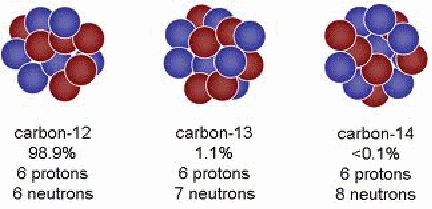All matter is made up of atoms. Each atom consists of a nucleus, made up of protons, which are positively charged, and neutrons, which have no charge. Orbiting the nucleus are electrons, which are negatively charged.
Atoms are divided into elements. Which element an atom is, is determined solely by the number of protons in the nucleus. This number is called the atomic number. The number of protons is exactly balanced by the number of electrons, since the atom as a whole is electrically neutral. It is actually the electrons that determine the chemical properties of an atom, since all chemistry is the interactions of the electrons around the nuclei of different atoms,
If the nucleus of an atom has a different number of neutrons but the same number of protons – and hence the same number of electrons around the atom – then it will be the same element and have the same chemical properties. Atoms with different numbers of neutrons but the same number of protons are called isotopes. All elements have isotopes. Isotopes of carbon are shown below, with their relative abundances.

The existence of isotopes means that the molar masses of elements as displayed in the periodic table are not whole numbers. Chlorine for example has two isotopes. One has 17 protons and eighteen neutrons – total mass 35 - with a relative abundance of 25% and the other has 17 protons and 20 neutrons – total mass 37 – with a relative abundance of 25%. The molar mass of chlorine is then ![]()
Many isotopes are unstable. They may be radioactive, emitting one of![]() or
or![]() radiation from the nucleus. Carbon - 14 is radioactive, emitting a %beta particle with a half life of 5730 years.
radiation from the nucleus. Carbon - 14 is radioactive, emitting a %beta particle with a half life of 5730 years.
